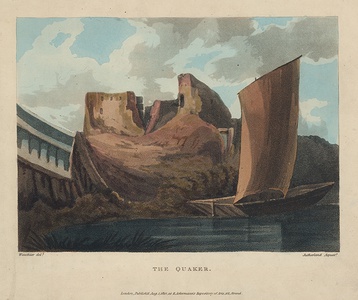| Method | Aquatint with hand colouring |
| Artist | Thomas Sutherland after John M. Wauthier |
| Published | London, Publish'd Aug. 1. 1810. at R. Ackermann's Repository of Arts, 101, Strand. |
| Dimensions | Image 165 x 227 mm, Sheet 245 x 303 mm |
| Notes |
A 'vexierbild', or puzzle picture, of a landscape which when held vertically creates the illusion of a Quaker's face. In the foreground a boat on the water's edge creates the shape of the Quaker's hat, whilst a dam's wall form his shirt. The remains of a building create the shape of his face, with a small waterfall forming his eye. We can find no institutional copies of this rare print despite being published by one of the leading publishers of the early 19th century. John M. Wauthier (fl. 1800-1825) was a British artist and cartographer. He is most known for his 1808 'Punchinello-graphy of England', a children's game in the form of a map of England and Wales with each English or Welsh county represented by a grotesque portrait of a character from history, literature or folklore. Wauthier also worked on atlases of ancient geography and European history with the publishers and printmakers Peter Didier and William Tebbett. Thomas Sutherland (1783-1838) was a British aquatint engraver, who apprenticed under the sporting engraver Samuel Alken. A prolific engraver, he worked principally in providing bookplates for Rudolph Ackermann and the Fullers. In 1813, he was found guilty of stealing a quantity of books from Ackermann and selling them to the print seller Peter Brown. Although this resulted in his dismissal, by 1819 he was back producing architectural plates for Ackermann. Rudolph Ackermann (1764 - 1834) was a lithographer and publisher born in Saxony. He moved to London in 1787 and later established a business as a coachmaker at 7 Little Russell Street, Covent Garden. In 1796, having already published the first of many books of carriage designs, he moved to 96 Strand where he ran a drawing school for ten years. The following year, Ackermann moved to 101 Strand (known, from 1798, as The Repository of Arts) where he sold old master paintings and artists' supplies as well as prints. In 1803, 220 Strand was given as his address in a print published that year. The Microcosm of London (1808-10) and the monthly Repository of Arts (1809-29) established his reputation for fine colour plate books. From 1816, he began to publish lithographs. Ackermann always maintained links with his native Germany, and in the 1820s, he also opened outlets in Mexico, Guatemala, Colombia, Argentina, and Peru. In 1832, he handed the running of the business over to his second son George and his younger brothers, who traded as Ackermann & Co.at 106 The Strand until 1861. Ackermann also established a print business for his eldest son Rudolph at 191 Regent Street. Condition: Some creasing and staining to the sheet edges and corners. Pin holes to left margin. Small tear to top sheet edge. |
| Framing | unmounted |
| Price | £400.00 |
| Stock ID | 53303 |

